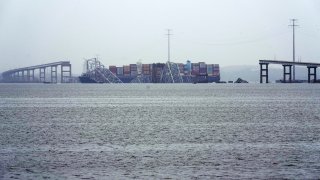
Rebuilding Baltimore’s collapsed Francis Scott Key Bridge could take anywhere from 18 months to several years, experts say, while the cost could be at least $400 million — or more than twice that.
It all depends on factors that are still mostly unknown. They range from the design of the new bridge to how swiftly government officials can navigate the bureaucracy of approving permits and awarding contracts.
Realistically, the project could take five to seven years, according to Ben Schafer, an engineering professor at Johns Hopkins University.
“The lead time on air conditioning equipment right now for a home renovation is like 16 months, right?" Schafer said. He continued: “So it’s like you’re telling me they’re going to build a whole bridge in two years? I want it to be true, but I think empirically it doesn’t feel right to me.”
Get top local stories in Connecticut delivered to you every morning. >Sign up for NBC Connecticut's News Headlines newsletter.
Others are more optimistic about the potential timeline: Sameh Badie, an engineering professor at George Washington University, said the project could take as little as 18 months to two years.
The Key Bridge collapsed Tuesday, killing six members of a crew that was working on the span, after the Dali cargo ship plowed into one its supports. Officials are scrambling to clean up and rebuild after the accident, which has shuttered the city's busy port and a portion of the Baltimore beltway.
The disaster is in some ways similar to the deadly collapse of Florida’s Sunshine Skyway Bridge, which was was struck by a freighter in Tampa Bay in 1980. The new bridge took five years to build, was 19 months late and ran $20 million over budget when it opened in 1987.
But experts say it's better to look to more recent bridge disasters for a sense of how quickly reconstruction may happen.
Jim Tymon, executive director of the American Association of State Highway and Transportation Officials, cited the case of the Interstate 35W bridge in Minnesota, which collapsed into the Mississippi River in 2007. The new span was up in less than 14 months.
“It’s the best comparison that we have for a project like this,” Tymon said. “They did outstanding work in being able to get the approvals necessary to be able to rebuild that as quickly as possible.”
Tymon expects various government agencies to work together to push through permits, environmental and otherwise.
“It doesn’t mean that all of the right boxes won’t get checked — they will,” Tymon said. “It’ll just be done more efficiently because everybody will know that this has to get done as quickly as possible.”
One looming issue is the source of funding. President Joe Biden has repeatedly said the federal government will pay for the new bridge, but that remains to be seen.
“Hopefully, Congress will be able to come together to provide those resources as soon as possible so that that does not become a source of delay,” Tymon said.
Minnesota Sen. Amy Klobuchar helped to obtain funding quickly to rebuild the I-35W bridge in her state. But she said replacing the Baltimore span could be more complicated.
She noted that the I-35W bridge, a federal interstate highway, was a much busier roadway with about 140,000 vehicle crossings a day, compared with about 31,000 for the Maryland bridge.
“But where there’s a will there’s a way, and you can get the emergency funding,” Klobuchar said. “It’s happened all over the country when disasters hit. And the fact that this is such a major port also makes it deserving of making sure that this all gets taken care of.”
Badie, of George Washington University, said the cost could be between $500 million and $1 billion, with the largest variable being the design.
For example a suspension bridge like San Francisco’s Golden Gate will cost more, while a cable-stayed span, like Florida's Skyway Sunshine Bridge, which handles weight using cables and towers, would be less expensive.
Whatever is built, steel is expensive these days and there is a backlog for I-beams, Badie said. Plus, the limited number of construction companies that can tackle such a project are already busy on other jobs.
“A project like this is going to be expedited, so everything is going to cost a lot more,” Badie said.
Hota GangaRao, a West Virginia University engineering professor, said the project could cost as little as $400 million. But that's only if the old bridge's pier foundations are used; designers may want to locate the new supports farther away from the shipping channels to avoid another collision.
“That’s going to be more steel, more complicated construction and more checks and balances,” GangaRao said. “It all adds up.”
Norma Jean Mattei, an emeritus engineering professor at The University of New Orleans, said replacing the Key Bridge likely will take several years. Even if it's a priority, the process of designing the span, getting permits and hiring contractors takes a lot of time. And then you have to build it.
“It’s quite a process to actually get a bridge of this type into operation,” she said.




